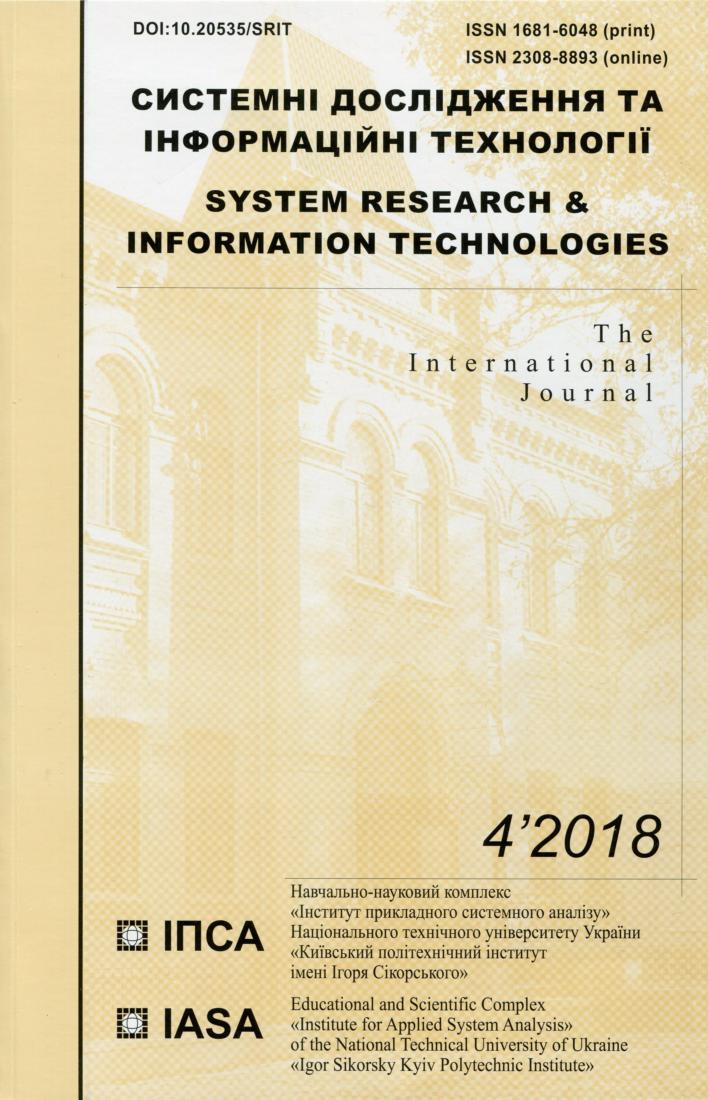Forecasting of solar activity by alternative methods
DOI:
https://doi.org/10.20535/SRIT.2308-8893.2018.4.10Keywords:
Adaptive Kalman Filter, Optimal Kalman Filter, Maximum Likelihood Method, Probabilistic Granular Filter, Sun Activity, Short Term ForecastingAbstract
The study is focused on the problem of forecasting nonstationary processes of solar activity using alternative procedures. The problem is urgent and it is considered by groups of researchers in many countries of the world. The processes under study belong to the class of nonlinear and nonstationary which requires selecting special methods for their modeling and forecasting. The study proposes an approach to forecasting based on three filters: the adaptive Kalman filter, optimal Kalman filter with parameter estimation using the maximum likelihood procedure and probabilistic particle filter. Selection of the filters is substantiated by the fact that they provide a possibility for taking into consideration stochastic external disturbances and measurement errors. The results of computational experiments showed the support for the idea that the methods selected are suitable for solving the problem stated. The best results of short-term forecasting of exponentially smoothed data were achieved using an adaptive filter. The analysis of results was performed by employing the known statistical quality characteristics including the mean absolute percentage error.References
Clette F. Revisiting the sunspot number / F. Clette, L. Svalgaard, J.M. Vaquero, E.W. Cliver. — Brussels: World Data Center Silso, 2016. — 80 p.
Henney C.J. Forecasting F10.7 with solar magnetic flux transport modeling / C.J. Henney, W.A. Toussaint, S.M. White, C.N. Arge // Space Weather. — 2012. — Vol. 10. — P. 1–9.
Huang X. Deep learning based solar flare forecasting / X. Huang, H. Wang, L. Xu et al. // The Astrophysical Journal. — 2018. — Vol. 856. — N 7. — P. 1–11.
Tharsini A.D. The Study of solar activity in relation with high frequency variations of solar radio flux / A.D. Tharsini, G. Shanti // American Journal of Astronomy and Astrophysics. — 2015. — Vol. 3. — N. 6. — P. 87–92.
Tapping K.F. Recent solar radio astronomy at centimeter wavelengths: The temporal variability of the 10.7-cm flux / K.F. Tapping // Journal of Geophysical Research: Atmospheres, 1987. — Vol. 92. — P. 829–838.
Schmahl E.J. Synoptic radio observations / E.J. Schmahl, M.R. Kundu // Synoptic Solar Physics. — 1998. — P. 387–400.
Svalgaard L. F10.7 Microwave Flux Matches the Total Disk Unsigned Magnetic Flux from MDI and HMI / L. Svalgaard, X. Sun // Technical Report, Hansen Experimental Physics Laboratory. — Stanford, CA 94305: Stanford University, 2016. — Available at: http://hmi.stanford.edu/hminuggets/?p=1510
Dudok deWit T. Synoptic radio observations as proxies for upper atmosphere modelling / T. Dudok deWit, S. Bruinsma, K. Shibasaki // Journal of Space Weather and Space Climate. — 2014. — P. 13–26.
Schonfeld S.J. Coronal Sources of the Solar F10. 7 Radio Flux / S.J. Schonfeld et al. // The Astrophysical Journal. — 2015. — P. 29–39.
Zgurovskij M.Z. Analiticheskie metody kalmanovskoj fil'tratsii dlja sistem s apriornoj neopredelennost'ju / M.Z. Zgurovskij, V.N. Podladchikov. — K.: Nauk. dumka, 1995. — 278 s.
Arulampalam S. A Tutorial on Particle Filters for on-line Non-linear/Non-Gaussian Bayesian Tracking / S. Arulampalam, S. Maskell, N. Gordon, T. Clapp // IEEE Trans. Signal Processing. — 2001. — Vol. 50. — P. 174–188.
Kozierski P. Resampling in particle filtering – comparison / P. Kozierski, M. Lis, J. Zietkiewicz // Studia z automatyki informatyki. — 2013. — Vol. 38. — P. 35–64.
Dovhyj S.O. Systemy pidtrymky pryjnjattja rishen' na osnovi statystychno-jmovirnisnykh metodiv / S.O. Dovhyj, O.M. Trofymchuk, P.I. Bidjuk. — K.: Lohos, 2014. — 419 s.
De Gooijer J. Elements of nonlinear time series analysis and forecasting / J. De Gooijer. — Berlin: Springer, 2017. — 620 p.

